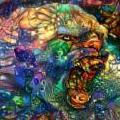Search the Community
Showing results for tags 'orchid'.
-
Vanda tessellata / roxburghii: This orchid is in medical use in Westbengal, India and Burma. When bees sip nectar from the flower, they crash down narcotized. Ayurvedic shamans use the flowers in a decoction, to put their patients in a hypnotic narcosis. The flowers are also used as aphrodisiac which is already clinically tested. The plant contains heptacosane, octacosanol, alkaloids, glycosides among others. The action is based on a stimulation of cholinergic neurons. Dose: 5-10g root (dried). Oncidium cebolleta- flower: (syn. Oncidium longifolium) Used by the tarahumara in Mexico als Peyote- substitute. There were found phenanthrene- alkaloids. Epipactis helleborine- flowers: Wasps are intoxicating themselfes with the nectar, become sluggish and crash down. The nectar contains the strongest opiate found in nature, oxycodone (not the strongest opioid because there are more potent peptides in the secretion of the frog Phyllomedusa bicolor). In the nectar there was found alcohol, indol-alcaloids and methoxyeugenol too. Cypripedium pubescens- root (cultivated): An orchid, which has become rare in nature, it is conservated. The north-american indians use the root to balance nerve-tensions and to counteract anxiety. In the dried tuber were found essential oils, resins, glycosides and tannines. It acts as a sedative, antidepressant, hypnotic and spasmolytic. High doses can be hallucinogenic. A normal dose can be 2-4g of the dried tubers. Gastrodia elata: An orchid which live parasitically on the fungus Armillaria mellea, which is on his part an parasite on trees. The tuber of the orchid is used in the traditional chinese medicine because of sedative, aphrodisiac and mentally strengthening actions. It has also anticonvulsant, antiinflammatory, neuroprotective and antidepressive actions. There was found the anxiolytic phenol gastrodin. Together with 4-hydroxybenzaldehyde it inhibits the breakdown of GABA. The plant has also action of glutamate-receptors. Dendrobium nobile- hybrid: It contains terpenalkaloids like nobilin and others. There are new reports on a psychoactive action like Cannabis from this orchid (with munchies, narcotic components,...): http://psychotropico...drobium-nobile/ But: Dendrobine is a GABA-antagonist. Dendrobium loddigesii- Stengel aus einer TCM-Apotheke: Dendrobium- species contain dendrophenol and also phenanthrenes. Both Dendrobiums are called "shi hu" in TCM. There are many reports of the aphrodisiac action. Dendrobium teretifolium is used as analgetic. Anoectochilus formosanus: contains GHB-like substances (4-hydroxybutanoic acids): http://www.ncbi.nlm....pubmed/18404313 It is a small decorative orchid from Taiwan, which is used because of liver-tonic, immunstimulating, antioxydative,... actions and is called "King Medicine". Bletilla striata: is described in China, Tibet and Mongolia as euphoriant, blood-purifying and blood-clotting. Cymbidium ensifolium: The intoxicating fragrance was inhaled by the japanese empress. Eulophia cucullata: Used in Africa as antiepileptic Goodyera schlechtendaliana: Sedative and anticonvulsant because of its goodyerin- content. It also contains the "GHB- glycoside" goodyeroside B. Jumellea fragrans syn. Angraecum fragrans: In Mauritius there is made a sedative tea from this plant. Tridactyle tricuspis: In Afrika used against madness Ghost-orchid (Polyrhiza lindenii): Used psychoactive in the film "Adaptation".
- 45 replies
-
- 23
-



